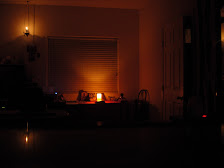August 18, 2007
As the Melbourne school of an ancient and arcane Orthodox art turns 25, its students and teacher still discover new spiritual depths and modern relevance, writes Barney Zwartz.
IF YOU CAN WRITE YOUR name, I can teach you to write an icon," Bishop John Bayton tells the growing multitudes who ask him about this arcane Eastern art.
And he does. Over the decades he has tutored hundreds in this venerable, deeply spiritual and meditative tradition - and many say it has changed their lives.
His icon school at St Peter's Eastern Hill, on the edge of the city, has 32 students, the maximum Bayton allows. It's had 32 almost constantly from the start - and a waiting list.
The school began with one student at the vicarage table. In weeks she was joined by an Anglican priest, then a professional draftsman. Soon it swelled to two classes, and has given birth to several other schools in Melbourne.
On August 30, the iconography school turns 25. Through its doors have passed Anglican and Catholic priests, nuns, Greek, Russian and Coptic Orthodox members, Presbyterian, Lutheran and Baptist ministers, Quakers, artists, housewives, students and retired people. Mostly they are Christians, but a few have been Jewish or agnostics.
For most it is an unorthodox pursuit, precisely because it is deeply Orthodox. That is, it belongs not to the Protestant or Roman Catholic wings of Christianity but the Eastern Orthodox. This tradition developed separately from the earliest days but especially after the first Christian emperor, Constantine, founded Constantinople (modern Istanbul) in the fourth century.
For the Orthodox, icons serve as a window into heaven. They are not so much art as a method of prayer, a hymn in colour that elevates and focuses the worshipper.
Bayton says: "An icon is an agreed point of encounter between the worshipper and the other world. It's a bit like the Aboriginal concept of Tjuringa, an agreed point of encounter between an ancestor and the present, called the Dreaming."
What about the Ten Commandments? The second reads: "Thou shalt not make unto thee any graven image, or any likeness of any thing that is in heaven above, or that is in the earth beneath, or that is in the water under the earth." (A strict understanding of this commandment led to the bitter and bloody iconoclastic clashes of the eighth and ninth centuries, though the second council of Nicea in 787 approved reverencing images.)
Read the rest here:
Akathist in Preparation for Jesus’ Second Coming
-
Discover the powerful Akathist in Preparation for Jesus’ Second Coming.
This deeply moving hymn calls Orthodox Christians to repentance,
watchfulness, an...
57 minutes ago









.jpg)






No comments:
Post a Comment